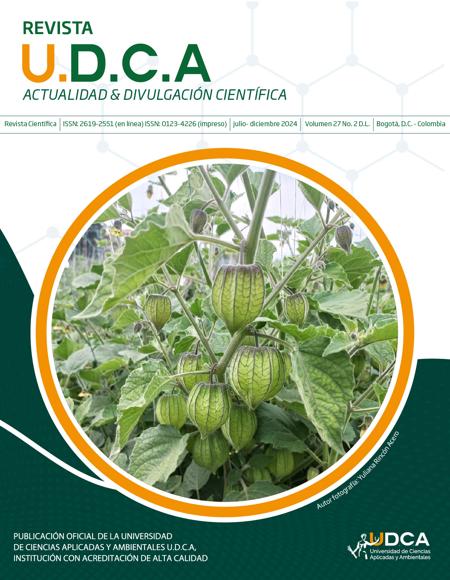Caracterización química, actividad bactericida y antioxidante de ácidos biliares presentes en la bilis de bovinos
Chemical characterization, bactericidal and antioxidant activity of bile acids present in the bile of bovines
Contenido principal del artículo
Resumen
Los ácidos biliares son biomoléculas con esqueleto esteroidal presentes en la bilis animal y humana, sintetizada en el hígado, a partir de la descomposición del colesterol y luego metabolizados por el microbiota intestinal. Se les atribuyen propiedades biológicas, farmacológicas, anticancerígena, antimicrobiana y terapéuticas; también exhiben efectos bacteriostáticos y bactericidas afectando a géneros, como Staphylococcus, Balantidium, Pneumococcus y Enterococcus; sin embargo, hay pocos estudios con actividad antioxidante apreciable. Por lo tanto, se extrajeron e identificaron químicamente los ácidos biliares aislados de la bilis de bovino (Bos), para determinar su potencial antioxidante y bactericida. Los ácidos biliares fueron derivatizados como ésteres metílicos y analizados mediante cromatografía de gases, acoplada a espectrometría de masas. La actividad bactericida se evaluó frente a Staphylococcus aureus y Pseudomona aeruginosa por el método de microdilución, con concentraciones entre 250 - 4000 μg/mL. El potencial antioxidante fue evaluado frente al radical libre 2,2-difenil-1-picrilhidracilo, a una concentración de 100 μg/mL. Los resultados mostraron la presencia de tres ácidos biliares: ácidos cólicos, ácido desoxicólico y ácido 7alfa-hidroxi-3-oxo-colan-24-oico. La inhibición del crecimiento bacteriano se alcanzó, en su totalidad, con los dos microorganismos evaluados, aún a la concentración más baja utilizada (250 μg/mL). La actividad antioxidante de los ácidos biliares frente al radical DPPH fue muy baja, presentándose un potencial de reducción de 8,9 % a la concentración utilizada. Esta investigación permitió contribuir con el estudio de las actividades biológicas y químicas de los ácidos biliares.
Palabras clave:
Descargas
Datos de publicación
Perfil evaluadores/as N/D
Declaraciones de autoría
- Sociedad académica
- Universidad de Ciencias Aplicadas UDCA
- Editorial
- Universidad de Ciencias Aplicadas y Ambientales U.D.C.A
Detalles del artículo
Referencias (VER)
AN, C.; CHON, H.; KU, W.; EOM, S.; SEOK, M.; KIM, S.; LEE, J.; KIM, D.; LEE, S.; KOO, H.; CHO, H.; HAN, S.; MOON, J.; KANG, M.; RYU, K. 2022. Bile acids: Major regulator of the gut microbiome. Microorganisms. 10(9):1792. https://doi.org/10.3390/microorganisms10091792 DOI: https://doi.org/10.3390/microorganisms10091792
BEGLEY, M.; GAHAN, C.G.M.; HILL, C. 2005. The interaction between bacteria and bile. FEMS Microbiology Revista. 29(4):625-651. https://doi.org/10.1016/j.femsre.2004.09.003 DOI: https://doi.org/10.1016/j.femsre.2004.09.003
BONALDI, A. 1993. Process for pharmaceutical grade high purity iodeoxycholic acid preparation (Patent No. 0564775A2). In European patent application. Disponible desde Internet en: https://patentimages.storage.googleapis.com/6e/2f/d4/821df1af80b2ab/EP0564775A2.pdf
CONTRERAS MARTÍNEZ, O.I.; ANGULO ORTÍZ, A.; SANTAFÉ PATIÑO, G. 2022. Antibacterial screening of isoespintanol, an aromatic monoterpene isolated from Oxandra xylopioides diels. Molecules. 27(22):8004. https://doi.org/10.3390/molecules27228004 DOI: https://doi.org/10.3390/molecules27228004
DAYAL, B.; SPECK, J.; BAGAN, E.; TINT, G.S.; SALEN, G. 1981. p-Toluenesulfonic acid/methanol: Mild reagent for the preparation of bile acid methyl esters. Steroids. 37(2):239-242. https://doi.org/10.1016/S0039-128X(81)80021-9 DOI: https://doi.org/10.1016/S0039-128X(81)80021-9
Di GREGORIO, M.C.; CAUTELA, J.; GALANTINI, L. 2021. Physiology and physical chemistry of bile acids. International Journal of Molecular Science. 22(4):1-23. https://doi.org/10.3390/ijms22041780 DOI: https://doi.org/10.3390/ijms22041780
DOS SANTOS, J.A.; POLONINI, H.C.; SUZUKI, É.Y.; RAPOSO, N.R.B.; DA SILVA, A.D. 2015. Synthesis of conjugated bile acids/azastilbenes as potential antioxidant and photoprotective agents. Steroids. 98:114-121. https://doi.org/10.1016/j.steroids.2015.03.009 DOI: https://doi.org/10.1016/j.steroids.2015.03.009
DUPONT, S.; FLEURAT-LESSARD, P.; CRUZ, R.G.; LAFARGE, C.; GRANGETEAU, C.; YAHOU, F.; GERBEAU-PISSOT, P.; ABRAHÃO JÚNIOR, O.; GERVAIS, P.; SIMON-PLAS, F.; CAYOT, P.; BENEY, L. 2021. Antioxidant properties of ergosterol and its role in yeast resistance to oxidation. Antioxidants. 10(7). https://doi.org/10.3390/antiox10071024 DOI: https://doi.org/10.3390/antiox10071024
ENEROTH, P.; GORDON, B.; RYHAGE, R.; SJÖVALL, J. 1966. Identification of mono- and dihydroxy bile acids in human feces by gas-liquid chromatography and mass spectrometry. Journal of Lipid Research. 7(4):511-523. https://doi.org/10.1016/S0022-2275(20)39261-0 DOI: https://doi.org/10.1016/S0022-2275(20)39261-0
FAUSTINO, C.; SERAFIM, C.; RIJO, P.; REIS, C.P. 2016. Bile acids and bile acid derivatives: use in drug delivery systems and as therapeutic agents. Expert Opinion on Drug Delivery. 13(8):1133-1148. https://doi.org/10.1080/17425247.2016.1178233 DOI: https://doi.org/10.1080/17425247.2016.1178233
GOBERNACIÓN DE CÓRDOBA, 2020. Gobernación de Córdoba Secretaría de Desarrollo Económico y Agroindustrial. Plan departamental de extensión agropecuaria departamento de Córdoba 2020-2023. Gobernación de Córdoba. 74p. Disponible desde Internet en: https://www.minagricultura.gov.co/ministerio/direcciones/PublishingImages/Paginas/PDEA/CORDOBA.pdf
GUZIOR, D.V.; QUINN, R.A. 2021. Review: Microbial transformations of human bile acids. Microbiome. 9(1):1-13. https://doi.org/10.1186/s40168-021-01101-1 DOI: https://doi.org/10.1186/s40168-021-01101-1
JAILLIER-RAMÍREZ, A.M.; WAITZBERG, D.; BECERRA R.A. 2021. Relación entre los ácidos biliares y el microbiota intestinal ¿es posible considerarlo como un factor etiológico en diversas colangiopatías? Una revisión narrativa. Revista de Nutrición Clínica y Metabolismo. 4(4):40-55. https://doi.org/10.35454/rncm.v4n4.287 DOI: https://doi.org/10.35454/rncm.v4n4.287
KANDRAC, J.; KEVRESAN, S.; GU, J.K.; MIKOV, M.; FAWCETT, J.P.; KUHAJDA, K. 2006. Isolation and determination of bile acids. European Journal of Drug Metabolism and Pharmacokinetics. 31(3):157-177. https://doi.org/10.1007/BF03190712 DOI: https://doi.org/10.1007/BF03190712
LAWSON, A.M.; SETCHELL, K.D.R. 1988. Mass spectrometry of bile acids. En: Setchell, K.D.R.; Kritchevsky, D.; Nair, P.P. (eds). The bile acids: Chemistry, physiology, and metabolism. Springer, Boston, MA. https://doi.org/10.1007/978-1-4613-0901-7_5 DOI: https://doi.org/10.1007/978-1-4613-0901-7
MARTÍNEZ MARTÍNEZ, M.A. 2002. Esteroles. Facultad de Química Farmacéutica, Universidad de Antioquia.
MISHRA, R.; MISHRA, S. 2020. Updates in bile acid-bioactive molecule conjugates and their applications. Steroids. 159:108639. https://doi.org/10.1016/j.steroids.2020.108639 DOI: https://doi.org/10.1016/j.steroids.2020.108639
NAVACCHIA, M.L.; MARCHESI, E.; PERRONE, D. 2020. Bile acid conjugates with anticancer activity: Most recent research. Molecules. 26:25. https://doi.org/10.3390/molecules26010025 DOI: https://doi.org/10.3390/molecules26010025
ORGANIZACIÓN DE LAS NACIONES UNIDAS PARA LA ALIMENTACIÓN Y LA AGRICULTURA, FAO; AGENCIA DE DESARROLLO RURAL. 2021. Plan integral de desarrollo agropecuario y rural con enfoque territorial; departamento de Córdoba. Divegráficas S.A.S. 170p. Disponible desde Internet en: https://www.adr.gov.co/wp-content/uploads/2022/03/Tomo-1-Cordoba.pdf
PARTRIDGE, L.G.; DJERASSI, C. 1977. Mass spectrometry in structural and stereochemical problems. 250. Characteristic Fragmentations of Cholesterol Acetate. The Journal of Organic Chemistry. 42(17):2799-2805. DOI: https://doi.org/10.1021/jo00437a001
PASTRANA FRANCO, O.; SANTAFÉ PATIÑO, G.; SÁNCHEZ ROMERO, E. 2019. Perfil lipídico y ensayos de las actividades antioxidante, insecticida y antialimentaria de la esponja marina Iotrochota birotulata (Iotrochotidae: Demospongiae). Revista de Biología Tropical. 67(1):213-223. https://doi.org/10.15517/RBT.V67I1.32357 DOI: https://doi.org/10.15517/rbt.v67i1.32357
PERSSON, E.; LÖFGREN, L.; HANSSON, G.; ABRAHAMSSON, B.; LENNERNÄS, H.; NILSSON, R. 2007. Simultaneous assessment of lipid classes and bile acids in human intestinal fluid by solid-phase extraction and HPLC methods. Journal of Lipid Research. 48(1):242-251. https://doi.org/10.1194/jlr.d600035-jlr200 DOI: https://doi.org/10.1194/jlr.D600035-JLR200
SÁYAGO-AYERDI, S.G.; VAQUERO, M.P.; SCHULTZ-MOREIRA, A.; BASTIDA, S.; SÁNCHEZ-MUNIZ, F.J. 2008. Utilidad y controversias del consumo de ácidos grasos de cadena media sobre el metabolismo lipoproteico y obesidad. Nutrición Hospitalaria. 23(3):191-202.
SANNASIDDAPPA, T.H.; LUND, P.A.; CLARKE, S.R. 2017. In vitro antibacterial activity of unconjugated and conjugated bile salts on Staphylococcus aureus. Front Microbiol. 8:1582. https://doi.org/10.3389/fmicb.2017.01581 DOI: https://doi.org/10.3389/fmicb.2017.01581
SHERIHA, G.M.; WALLER, G.R.; CHAN, T.; TILLMAN, A.D. 1968. Composition of bile acids in ruminants. Lipids 3(1):72-78. https://doi.org/10.1007/BF02530972 DOI: https://doi.org/10.1007/BF02530972
SINGH, N.; BHATTACHARYYA, D. 2016. Identification of the anti-oxidant components in a two-step solvent extract of bovine bile lipid: Application of reverse phase HPLC, mass spectrometry and fluorimetric assays. Journal of Chromatography B Analyt Technol Biomed Life Science. 1019:83-94. https://doi.org/10.1016/J.jchromb.2015.11.020 DOI: https://doi.org/10.1016/j.jchromb.2015.11.020
SINGH, A.N.; BARUAH, M.M.; SHARMA, N. 2017. Structure based docking studies towards exploring potential anti-androgen activity of selected phytochemicals against prostate cancer. Science Report. 7(1):1955. https://doi.org/10.1038/S41598-017-02023-5 DOI: https://doi.org/10.1038/s41598-017-02023-5
SUNG, J.Y.; SHAFFER, E.A.; COSTERTON, J.W. 1993. Antibacterial activity of bile salts against common biliary pathogens. Effects of hydrophobicity of the molecule and in the presence of phospholipids. Digestive Diseases and Sciences. 38(11):2104-2112. https://doi.org/10.1007/BF01297092 DOI: https://doi.org/10.1007/BF01297092
TOKES, L.; JONES, G.; DJERASSI, C. 1968. Mass spectrometry in structural and stereochemical problems. CLXI. Elucidation of the course of the characteristic ring d fragmentation of steroids. Journal of the American Chemical Society. 90(20):5465-5477. https://org/doi.org/10.1021/ja01022a025 DOI: https://doi.org/10.1021/ja01022a025
VALLE Z., H:A.; SANTAFÉ P., G.G. 2009. Esteroles libres de la esponja marina Mycale laevis. Vitae. 16(1):103-109. DOI: https://doi.org/10.17533/udea.vitae.1431







